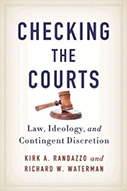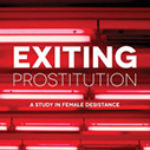Checking the Courts: Law, Ideology, and Contingent Discretion

Authors: Kirk A. Randazzo and Richard W. Waterman
Publisher: Albany, NY: State University of New York Press, 2014. 215p.
Reviewer: Jack E. Call | March 2015
One of the enduring issues in the study of judicial behavior concerns the extent to which (if any) judges are constrained by the law. The Attitudinal Model has been the dominant paradigm in the field. It holds that judges’ decisions are motivated by their personal ideological preferences. The Legal Model, the primary opposing explanation for judicial behavior, holds that judges’ decisions are greatly influenced by existing law. Their ideological preferences affect their decisions only when existing law is unclear.
Advocates for the Attitudinal Model defend their position, in part, by pointing out the absence of empirical evidence to support the Legal Model (while pointing to the extensive body of empirical evidence supporting the Attitudinal Model). Checking the Courts attempts to fill this empirical void by examining the impact of statutes on decisions of the U.S. Supreme Court, the U.S. Courts of Appeals, and state supreme courts.
The authors propose a Model of Contingent Discretion – as statutes increase in detail, judges will be more constrained in their decision-making, and their personal ideological preferences will exert less influence on their decisions. To test their model, reported cases involving statutory interpretation by the U.S Courts of Appeals (from 1925-2002), the U.S. Supreme Court (from 1953-1998), and state supreme courts (1995-1998) were analyzed. In all analyses, the dependent variable was whether each judge voted in a “sincere manner” (i.e. whether a liberal judge voted for a liberal outcome or a conservative judge voted for a conservative outcome).
The independent variables were Statutory Detail (the natural log of the total number of words in the statute being interpreted); Liberal Statutory Detail (a dummy variable indicating whether a judge was liberal or not, to control for the differential effect of a statute on liberal and conservative judges); Ideological Intensity of each judge (a score for federal judges based on each judge’s appointing President and confirming Senator and for state court judges a PAJID developed by Brace, Hall, and Langer (2000)); and, Judicial Review (indicating whether the court was also considering the constitutionality of the statute under review).
The analysis of U.S. Supreme Court cases included two additional independent variables – Lower Court Congruence (indicating the disposition of the case by the court below) and Minimum Winning Coalition (a term the authors never define). The analysis of state supreme court cases included four additional independent variables – Age of Statute (the length of time between passage of the statute and the appellate decision), Partisan Balance of the State Legislature (the proportion of Democratic state legislators to Republican state legislators), a dummy variable to control for the presence of an intermediate court of appeals in the state, and Judicial Professionalism (based on a professionalism measure developed by Squire (2008) – a source omitted from the list of references in the book).
In addition to these analyses, the authors also examine the effect of previous judicial interpretations on judicial discretion. The assumption is that frequent prior judicial interpretation of a statute overrides the constraints imposed on judges by detailed statutes, giving judges greater freedom to decide a case based on their ideological preferences. The extent of prior judicial interpretation is measured by the number of annotations relevant to a statute, as reported in Lexis-Nexis. (This analysis is conducted for the U.S. Supreme Court cases only).
The analyses conducted by the authors suggest that, as anticipated, statutes written with more detail provide greater guidance to judges and limit substantially the ability of judges to decide cases of statutory interpretation in accordance with their ideological preferences. There is also support here for another outcome anticipated by the authors – longer statutes facilitate the ability of judges to vote in accordance with their ideological preferences when those preferences are consistent with the ideological slant of the statute.
In addition, the analysis of judicial annotations suggests that frequent interpretation of a statute has a countervailing influence on the exercise of judicial discretion. If the length of the statute has a constraining impact on judges, the presence of extensive prior judicial interpretation of the statute tends to eliminate the constraining effect of the statute’s length and permits judges greater discretion. Conversely, if the statute length facilitated a judge’s decision in accordance with the judge’s ideological preferences, the presence of extensive judicial interpretation exercised a constraining effect on the judge’s discretion to decide the case as the judge’s ideology would have dictated.
These findings are significant and represent a very important contribution to a very important question. However, they represent initial efforts to address empirically the validity of the Legal Model, and like most such initial efforts, there are important methodological questions about the analyses conducted to test the authors’ hypotheses.
To their great credit, the authors raise some issues on their own. Specifically, they point out that their model does not account for or measure precedent, nor is there any control for the substantive meaning of any particular statute. (The authors are not as clear about these points as they could have been. It may be that they have in mind some of the questions raised below, especially the questions raised about the assumptions that criminal laws are conservative, civil liberties laws are conservative, and economic laws are more neutral). They also point out that their study makes no attempt to take into account the very possible impact that the executive branch may exert on judicial discretion.
One of the key initial assumptions in the authors’ reasoning about the Model of Contingent Discretion is that longer statutes contain more detailed language that might serve to limit judicial discretion. To support this assumption, validity tests were conducted by the authors to confirm the assumption. However, there is no description of the nature of these tests, nor is any authority cited to support the appropriateness of the methods used.
The authors also chose to limit their analysis to criminal, civil liberties (including a civil rights subset of these cases), and economic statutes. They assume that criminal statues are conservative, that civil liberties cases are conservative, that civil rights statutes are liberal, and that economic statutes have a neutral effect. The presumption is that if liberal judges are casting many liberal votes in criminal cases, for example, the longer criminal statutes are not having the expected constraining effect. The problem, of course, is that it is unreasonable to think that all criminal statutes are conservative or that all civil rights statutes are liberal. The authors’ justification for these assumptions seems to be that it is based on “conventional wisdom” (although no sources in support of that conventional wisdom are cited). Also, no explanation is provided as to why these particular subject areas were selected and others were excluded.
Another critical aspect of the analysis was the classification of judicial ideology in the U.S. Court of Appeals cases. The authors use the methodology developed by Giles, Hettinger, and Peppers (2001), awarding a score based on the president who appointed and the senator who confirmed the judicial appointment (under the practice of senatorial courtesy) as “a suitable surrogate for judicial ideology.” While it is, of course, appropriate to utilize the methodology of other scholars to operationalize a variable, it would be useful to explain why the authors think that methodology is sound.
The authors include the independent variable Judicial Review because they expect that judges will be less constrained when they have been called upon to exercise that power. The rationale for that assumption is not explained, but more important may be the question of why these cases should be included in the analysis at all. Because the authors assume that judges have more discretion when they are interpreting a constitutional provision, this may raise additional questions about why judges were addressing the statutory interpretation issue at all. Could it be that when the judges exercised their power of judicial review and found a statute unconstitutional, they ignored the statutory interpretation issue altogether, but they addressed that issue when they found the statute constitutional? If so, it seems likely the former group of cases would be excluded from the authors’ database, thereby possibly skewing the data.
In the analysis of U.S. Supreme Court cases, cases with no “clear ideological decision” were eliminated (in accordance with “standard practice”). There is no explanation as to how this determination was made, nor is any authority cited in support of the statement that this is standard practice. What’s more, as noted earlier, an independent variable called Minimum Winning Coalition was added to the analysis of this group of cases, but no explanation was provided as to what this variable means (or how it was measured).
In the analysis of state supreme court cases, the authors reexamined the criminal cases included in that analysis to control for “saliency,” speculating that some cases may not have been useful to the analysis because they raised only frivolous or unimportant issues. They did this by looking only at death penalty cases. It is not clear why this would have the intended effect. Also, it is not clear why this should have been an issue of concern only in the state cases and not in the U.S. Court of Appeals cases.
In the chapter examining the extent to which prior interpretation of a statute by courts impacts the ability of Supreme Court justices to vote in a sincere manner, the authors introduced an independent variable to measure the extent of judicial interpretation of a statute based on the number of words contained in the annotations of the statute in Lexis-Nexis. However, this approach does not take into account that the length of an annotation may well be influenced by the “style” of individual annotators at Lexis-Nexis. It seems likely that some analysts will be more inclined to shorter (or longer) summaries than other analysts. Also, there is no indication as to whether all annotations were included in the word count when the same case was included in multiple annotations. In addition, it is not clear why this analysis was done only for the effect on Supreme Court justices, rather than the effect on lower appellate court judges.
The authors also excluded from their analysis all cases that came before the Court only once. They indicate that cases that come before the Court only once “have few or no annotations connected to them.” It is not clear why this should be true, and no evidence is presented to support the conclusion. Nor was any effort made to analyze the annotations to determine if they were consistent in their interpretation of the statute in question (which would seem not to reduce the constraints imposed by statutory language) or whether the annotations reflect varying interpretations of statutory language (which would seem to give judges more discretion in their interpretation of statutes). The authors say “we expect the judicial annotations to include a variety of opinions,” but they present no evidence to support that expectation.
None of these questions should be interpreted to mean that this study is not important. As indicated at the outset, the questions addressed in this study are important, and the authors deserve much credit for the extensive and unquestionably time-consuming research reported in this book. The authors simply face what all ground-breaking research faces – the critical analysis of their methodology with a view toward enhancing the subsequent replication of their work which is almost certain to follow – as it clearly should.
References:
Brace, Paul, Melinda Gann Hall, and Laura Langer (2000). Measuring the Preferences of State Supreme Court Justices. Journal of Politics, 62(May), 387-413.
Giles, Michael W., Virginia A. Hettinger, and Todd Peppers (2001). Picking Federal Judges: A Note on Policy and Partisan Selection Agendas. Political Research Quarterly, 54(September), 623-641.
Jack E. Call, Professor of Criminal Justice, Radford University


